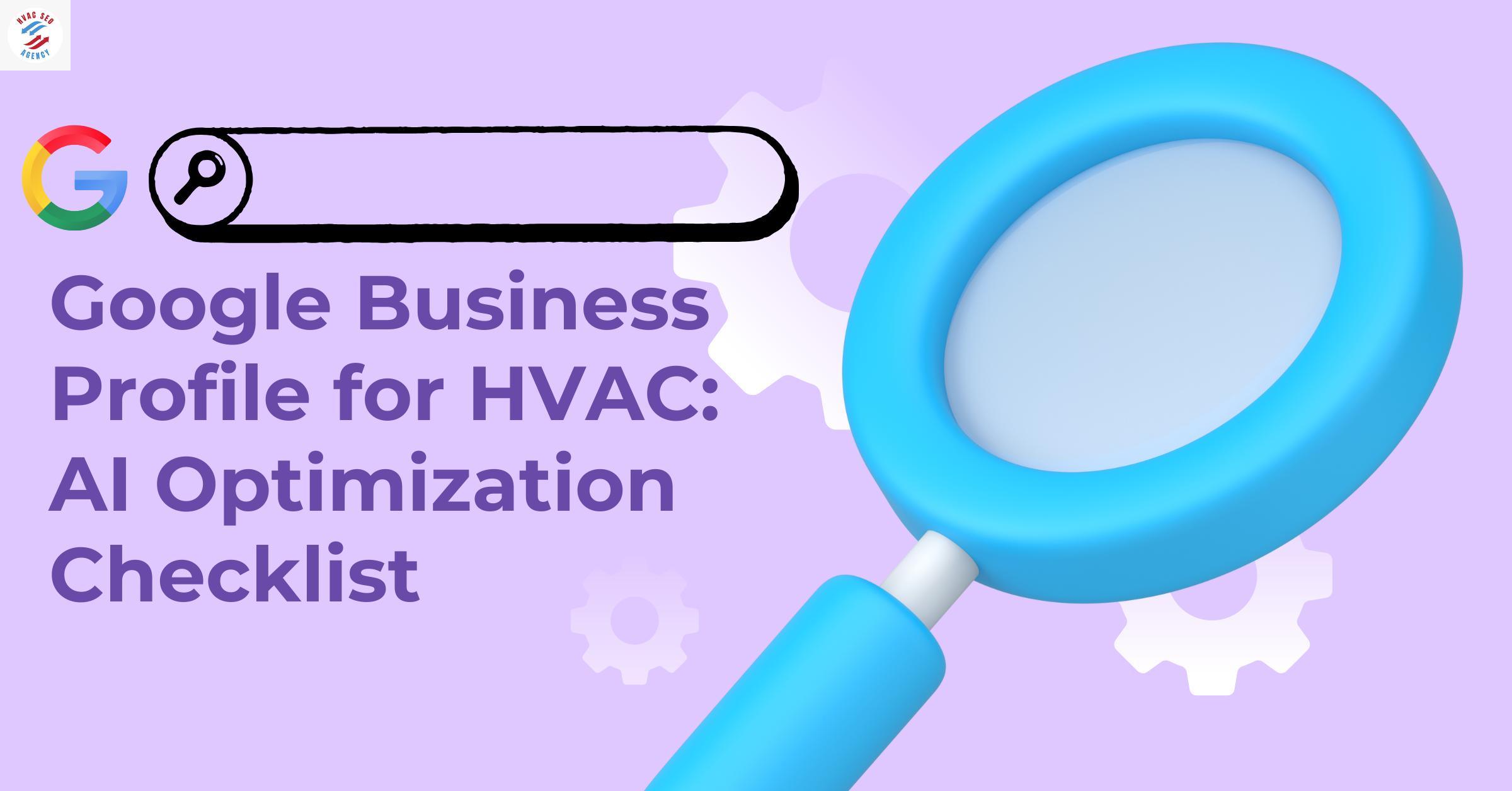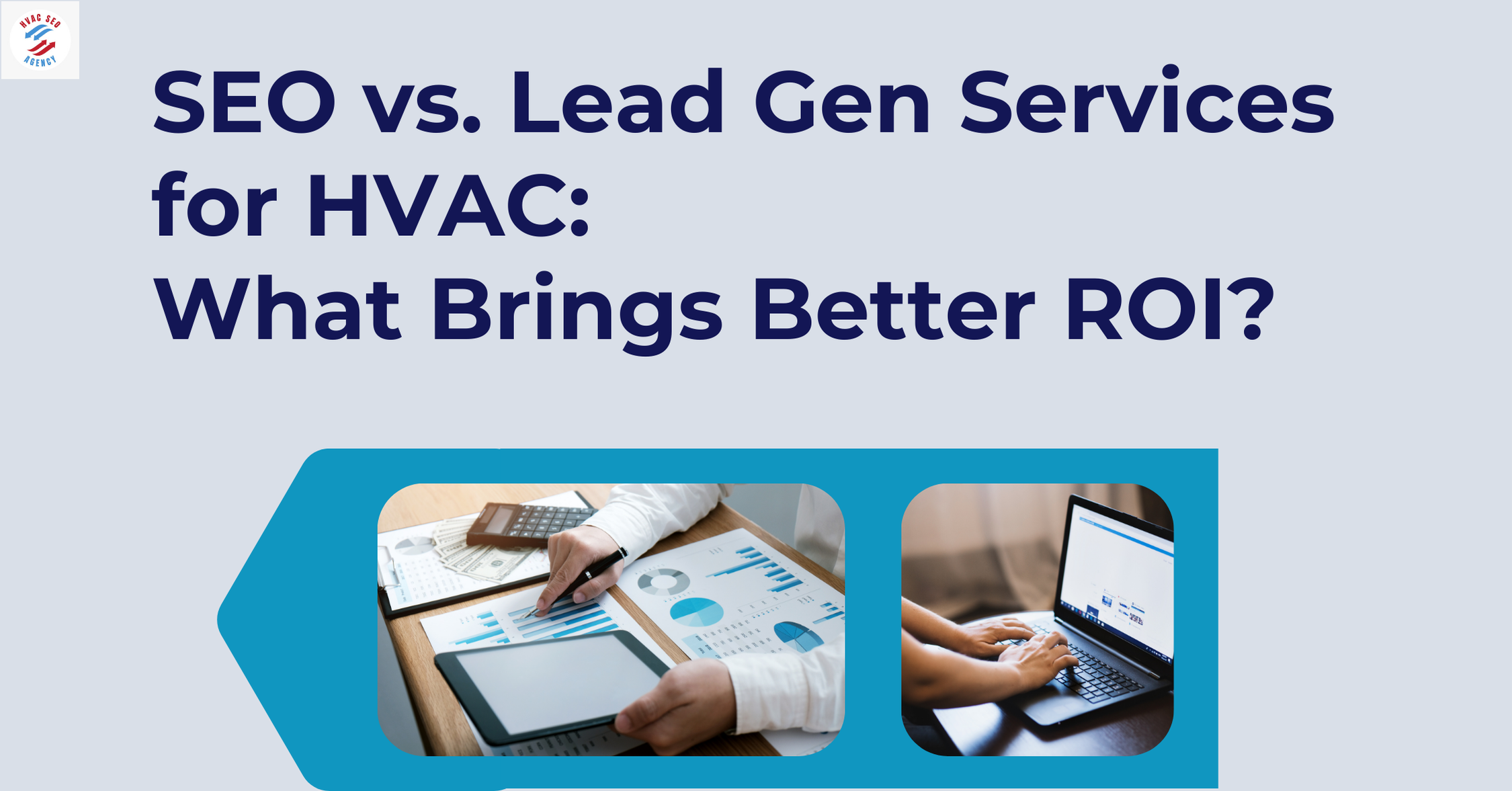Blogging for HVAC Businesses: How to Create Content That Attracts Clients

1. Why Blogging Matters for HVAC Businesses in 2025
In the competitive U.S. HVAC market, traditional marketing is no longer enough. To consistently attract high-intent clients, HVAC businesses must prioritize digital visibility. One of the most powerful yet underutilized tools is blogging. Strategic content creation not only drives organic traffic but also supports your paid campaigns and SEO performance long-term.
HVAC Blogging: The Foundation of Inbound Success
HVAC blogging allows businesses to establish topical authority, rank for local and national keywords, and answer the exact questions potential clients are searching for. When combined with other digital channels like PPC for HVAC Contractors blogging ensures you’re visible at every stage of the buyer’s journey, from research to booking.
Stat Insight: According to a 2024 HubSpot report, companies that blog receive 55% more website visitors and 67% more leads per month than those that don’t.
PPC Alone Is Not Enough Without Supporting Content
While PPC for HVAC Contractors can bring short-term leads, it’s often expensive and unsustainable without a content ecosystem. A well-structured blog strategy lowers your cost-per-lead over time by driving organic traffic that converts even when ad spend is paused.
Source: WordStream HVAC Industry Benchmarks 2024
Why Localized SEO Services Matter
Businesses working with the Best HVAC SEO Marketing Services in Atlanta or any major U.S. city often outperform competitors because they use geo-targeted blogging. Local content optimized with specific service areas helps rank higher in Google Maps and Local Pack results, which generate the majority of HVAC service inquiries.
One of the biggest mistakes HVAC businesses make is only publishing sales-driven content. Today’s clients expect value upfront. Blogging offers the perfect platform to educate homeowners and business owners on HVAC care, energy efficiency, and long-term maintenance—building both trust and SEO performance.
Why Informational Posts Outperform Hard Sales
Google’s Helpful Content guidelines (2025 update) reward blog posts that provide user-first value. Informational guides not only rank higher but also generate backlinks, social shares, and engagement all crucial signals for organic visibility. A blog titled “How to Extend the Lifespan of Your HVAC System” can rank for multiple related queries, such as:
How to maintain an HVAC system
Tips for HVAC efficiency
When to replace HVAC parts
Stat Insight: A 2023 BrightLocal study found that 76% of HVAC service customers read 3+ blog articles or service pages before contacting a provider.
What Topics Actually Convert?
Educational posts that extend the lifespan of your HVAC system tend to have the highest time-on-page and conversion rates. These blogs don’t just attract traffic, they attract high-intent users who are looking to maintain or upgrade their HVAC systems.
Source: HVAC Blog Benchmarking Report, SEMrush + LocalIQ (2024)
Connecting Value-Driven Content to Revenue
By publishing optimized content such as “How to Extend the Lifespan of Your HVAC System,” you attract proactive homeowners who are more likely to sign up for annual maintenance plans or long-term service agreements as key sources of recurring revenue.
Include internal linking strategy: Link blog articles to maintenance service pages and consultation forms.
Effective HVAC blogging starts with knowing what your potential clients are actually searching for. Keyword research isn't just about ranking, it's about aligning your content with client intent. HVAC businesses that publish based on data-driven keyword strategy consistently outperform competitors in traffic, leads, and local visibility.
Why Keyword Intent Matters More Than Volume
It’s easy to chase high-volume keywords, but smart HVAC content marketing focuses on user intent. A keyword like “best air conditioner for a small apartment” may have moderate search volume, but converts better than broad terms like “air conditioning”. Long-tail, localized, and question-based keywords are essential for HVAC blogging that drives ROI.
Stat Insight: According to Ahrefs (2024), 92.42% of keywords get fewer than 10 monthly searches but they convert 3–5x higher than high-volume terms when matched with proper blog content.
Must-Use HVAC Blog Keyword Types
Here are categories HVAC bloggers must cover to attract a wide range of client needs:
Tools to Build Your Keyword List
For effective HVAC content marketing, use keyword tools that provide location-based insights and SERP features:
Google Keyword Planner – Ideal for ad-based search demand
Ahrefs/SEMrush – For difficulty, volume, and competitor insights
AnswerThePublic – For blog content ideas from real queries
Google Search Console – For refining blog content based on live performance
Use your primary and secondary keywords like “HVAC blogging” and “HVAC content marketing” naturally in subheadings, intro, conclusion, and image alt texts. Overstuffing can lower your ranking due to Google's Helpful Content System.
4. Blog Topics That Drive Repeat Visitors and Long-Term Engagement
To make HVAC blogging work as a lead generation machine, you need to focus not just on clicks but on return visits and engagement. Clients trust brands that continuously provide value through actionable and relevant information. That’s why creating evergreen blog topics is a powerful HVAC content marketing strategy.
Evergreen Content Keeps Working After It’s Published
Unlike seasonal posts, evergreen blog content continues to attract traffic, backlinks, and shares for months or even years after it’s published. These high-performing posts often revolve around topics like:
Top 10 HVAC Maintenance Tips for Homeowners
Signs It’s Time to Replace Your HVAC Unit
Energy-Saving HVAC Hacks for the Summer
Stat Insight: A study by Backlinko (2024) found that evergreen blog posts generate 72% more backlinks and have a 27% lower bounce rate than time-sensitive content.
Use Blogging to Promote Maintenance Plans
Educational content like “How to Extend the Lifespan of Your HVAC System” naturally sets the stage to promote annual HVAC maintenance contracts. These blogs convert well because readers are already seeking ways to care for their systems long-term. Add a call-to-action at the end directing users to your maintenance plan or service agreement page.
Keep Readers Hooked With Internal Links
Use internal linking to keep readers engaged. For example, link the “Extend the Lifespan of Your HVAC System” post to:
Your maintenance plan sign-up page
A related post on HVAC filter replacements
A guide on common HVAC issues
5. How to Structure HVAC Blog Posts for Maximum Engagement and SEO
Even great content fails if it’s not presented in a way that’s readable, skimmable, and SEO-friendly. Structuring your HVAC blog posts correctly helps readers stay longer and take action while also giving Google the context it needs to rank your content higher.
Ideal Blog Structure for HVAC Blogging
Use the following proven structure for each blog post:
Headline (H1): Use primary keywords like HVAC blogging clearly and early.
Introduction (100–150 words): Address the user’s problem and preview the solution.
Subheadings (H2, H3): Use questions or keyword variations like HVAC content marketing, how to extend the lifespan of your HVAC system, etc.
Bullet points & numbered lists: Improve readability.
Images and charts: Reduce bounce rate and increase shareability.
Call-to-action: Always link to service pages or lead capture forms.
Stat Insight: According to Yoast (2024), blog posts that include more than 3 H2s, at least one image, and a CTA within the first 800 words have a 38% higher dwell time and 22% more conversions.
SEO Elements to Always Include
Title: 7 Expert Tips to Extend the Lifespan of Your HVAC System
Intro: Explain why HVAC systems wear out prematurely
Sections:
Change filters regularly
Schedule seasonal tune-ups
Clean your ducts
Install a smart thermostat
Watch for strange noises
Clear debris around outdoor unit
Work with certified HVAC professionals
Publishing comprehensive guides on complex HVAC services positions your business as a trusted authority. One of the most effective blog formats in HVAC blogging is the how-to guide. These posts not only attract organic traffic but are frequently bookmarked, shared, and linked to boosting your SEO performance significantly.
Why Installation Guides Work for HVAC Content Marketing
Homeowners often research HVAC installation processes before calling a contractor. A transparent, detailed Step-by-Step Guide to Residential HVAC Installation helps demystify the process and creates trust with readers. It also attracts serious, high-intent traffic ready to convert into leads or service calls.
Stat Insight: Content with step-by-step instructions has 35% higher engagement rates and a 41% higher conversion rate compared to generic blog formats (Source: Content Marketing Institute, 2024).
Complete Step-by-Step Guide to Residential HVAC Installation
Initial Home Evaluation
Assess square footage, insulation, layout, and ductwork needs.Selecting the Right HVAC System
Choose based on SEER rating, fuel type (gas, electric, hybrid), and size.System Design & Load Calculations
HVAC techs perform Manual J calculations to ensure efficiency.Permitting & Compliance
Secure necessary building permits and comply with local codes.Ductwork Inspection or Replacement
Old ductwork is evaluated and either reused or replaced.Installation Day Prep
Area is cleared, equipment delivered, safety protocols followed.System Installation
Units are installed, duct connections sealed, wiring completed.Thermostat Setup & Smart Integration
Install a programmable or smart thermostat.Testing and Calibration
Ensure airflow, temperature control, and refrigerant levels are accurate.Final Walkthrough and Maintenance Plan Offer
Educate the homeowner and introduce an annual service agreement.
Internal Linking Opportunity
Link this guide to related blog posts like:
“How to Extend the Lifespan of Your HVAC System”
“Common HVAC Installation Mistakes”
“Best HVAC Tools Every Technician Should Own”
One of the most overlooked yet highly effective strategies in HVAC blogging is publishing real-life success stories. Case studies provide undeniable proof that your services work. They also enhance your business's credibility, increase dwell time, and contribute significantly to EEAT (Experience, Expertise, Authority, and Trust).
Why Case Studies Convert Better Than Generic Content
Readers are more likely to trust actual results than marketing claims. A well-documented blog post showing how your HVAC service helped a local homeowner extend the lifespan of their HVAC system builds confidence and prompts action.
Stat Insight: According to Demand Gen Report (2023), 78% of buyers say case studies are the most influential type of content in the decision-making process.
What to Include in a Great HVAC Case Study Blog Post
Client: 2,400 sq. ft. home in suburban Atlanta
Issue: Frequent HVAC shutdowns during summer peak
Our Solution: Replaced air handler, optimized ductwork, set up a smart thermostat
Outcome: Improved airflow, 30% drop in electricity bill, no shutdowns for 2 years
Testimonial: “They saved us from another summer nightmare!”
Where to Promote Case Study Blogs
Add to your homepage under “Client Stories”
Share on Google Business Profile posts
Repurpose into a short video for YouTube or social media
Include as internal links within service or blog pages
8. Optimizing HVAC Blog Posts for Local SEO
Local SEO is the backbone of HVAC content marketing, especially when you're targeting service-based leads. Blogs that are optimized for specific cities, counties, or ZIP codes tend to rank faster and convert better. In fact, combining HVAC blogging with local SEO is one of the most effective ways to attract ready-to-buy customers within your service area.
Why Local Content Dominates the HVAC Industry
Searches like “AC repair near me” or “HVAC installation in Dallas” have high commercial intent. Google prioritizes businesses that offer relevant local content. A blog titled “How to Extend the Lifespan of Your HVAC System in Atlanta’s Humid Climate” not only performs well but also supports your Google Business Profile, maps ranking, and organic visibility.
Stat Insight: 88% of local mobile searches for HVAC services result in a call or visit within 24 hours (Source: Google Local Consumer Behavior Report, 2024).
How to Localize Your HVAC Blog Content
Original Blog Title:
“How to Extend the Lifespan of Your HVAC System”
Localized Blog Title:
“How to Extend the Lifespan of Your HVAC System in Phoenix’s Extreme Heat”
This small change can improve CTR by 25% or more in local search results.
Internal Tip: Work with Local SEO Experts
Partnering with the Best HVAC SEO Marketing Services in Dallas or other cities helps align your blog strategy with local ranking factors. These professionals know how to structure your blog for Google’s local pack, ensuring you’re seen by clients in your area.
Publishing quality content is only the first step—promotion is what drives visibility and ROI. Without distribution, even the most valuable HVAC blogging efforts can go unnoticed. A strategic promotion plan ensures your blogs reach the right audience across multiple touchpoints and generate qualified HVAC leads consistently.
Top Channels to Promote HVAC Blog Content
Stat Insight: Businesses that promote blog posts across 3+ channels receive 2.3x more traffic and 48% higher lead conversions compared to those relying on organic SEO alone (Source: Content Marketing Institute, 2024).
How to Use Paid Ads to Boost Blog Visibility
Running short-term PPC campaigns to promote educational blog content—such as “How to Extend the Lifespan of Your HVAC System”—can dramatically reduce your overall cost per lead over time. These campaigns drive traffic to your blog first, then retarget readers with service offers.
Tip: Use Facebook or Google Display Network to promote blogs under $0.40 CPC in most U.S. cities.
Retargeting: Show follow-up service ads to readers who spend 2+ minutes on your blog.
Collaborate with Local Influencers or Property Managers
Reach out to real estate agents, apartment communities, or home improvement influencers in your city. Offer guest content or cross-promotions where your HVAC blog gets featured. This tactic earns backlinks and local authority, further boosting your HVAC content marketing strategy.
10. Measuring the ROI of HVAC Blogging
For HVAC blogging to be more than just a branding tool, you must track performance and tie it back to business results. This is where many HVAC companies fall short—publishing content but failing to measure what matters. Data-driven HVAC content marketing ensures that every blog you write contributes to visibility, traffic, leads, and revenue.
Key Metrics to Track Blog Performance
Stat Insight: HVAC companies that publish 4+ optimized blogs per month and track ROI see a 126% increase in organic leads within 6–9 months (Source: HubSpot State of Content Marketing Report, 2024).
Sample Blog ROI Analysis
Let’s say you published a blog titled “How to Extend the Lifespan of Your HVAC System”:
Traffic: 2,400 visitors in 60 days
Avg. Time on Page: 4.5 minutes
Conversion Rate: 6.5% → 156 leads
Estimated Close Rate: 40% → 62 jobs
Avg. Job Revenue: $550
Estimated Revenue from One Blog: $34,100
Tools to Streamline Blog ROI Tracking
Google Search Console – Identify blog pages gaining visibility
Google Tag Manager – Set up conversion tracking from blog to form
HubSpot/Zoho CRM – Attribute leads and revenue to blog touchpoints
UTM Parameters – Track blog performance from email or paid ads
Why This Matters
When you track ROI properly, HVAC blogging shifts from a “nice-to-have” to a top-performing marketing asset. It justifies continued investment and helps you scale faster with confidence.
1. How often should HVAC companies publish blog posts?
To stay competitive in the U.S. market, HVAC companies should aim to publish at least 4 high-quality blog posts per month. This frequency improves crawlability, keyword coverage, and user engagement, especially when posts are optimized for local SEO and user intent.
2. What topics work best for HVAC blogs?
High-performing topics include:
“How to Extend the Lifespan of Your HVAC System”
Seasonal HVAC checklists
Common HVAC problems and fixes
Local HVAC rebates and energy efficiency tips
Step-by-step guides on installation, maintenance, and system upgrades
3. Can HVAC blogging replace paid advertising?
Not entirely—but it can significantly reduce your paid ad budget over time. Blogging builds organic traffic and brand trust, which lowers cost-per-lead and supports PPC campaigns with high-intent retargeting.
4. How long does it take to see results from HVAC content marketing?
With consistent effort, optimized posts, and proper promotion, you can begin seeing traffic and lead growth within 90–120 days, with compounding ROI over 6–12 months.
5. Should we hire a professional agency for HVAC blogging?
Yes—especially if you want to rank fast, outpace local competitors, and avoid content mistakes that harm your Google rankings. Partnering with the best HVAC SEO marketing services in Atlanta or your service area ensures your blogs are optimized for both search engines and conversions.
Conclusion: Turn Your HVAC Blog Into a Lead-Generating Powerhouse
HVAC blogging isn’t just a content strategy, it's a long-term business growth engine. From educational guides and case studies to local SEO and promotional strategies, every blog you publish brings you closer to building trust, improving visibility, and securing high-value clients.
If done right, your blog becomes more than words it becomes your 24/7 sales machine. Whether your goal is to extend the lifespan of your HVAC system for customers, promote installations, or boost maintenance plans, blogging is the most scalable and cost-effective strategy for the modern HVAC business.






